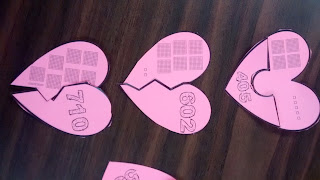
 I am finishing out the #FractionsFebruary blog tour put on by Math Solutions. I had the privilege of interviewing Julie McNamara, author of Beyond Pizzas & Pies and Beyond Invert & Multiply. I love reading about teaching fractions and always feel like there is more I can learn. I read both of these books about a year and a half ago and they brought great changes to my teaching practice, especially the idea of using cuisenaire rods
I am finishing out the #FractionsFebruary blog tour put on by Math Solutions. I had the privilege of interviewing Julie McNamara, author of Beyond Pizzas & Pies and Beyond Invert & Multiply. I love reading about teaching fractions and always feel like there is more I can learn. I read both of these books about a year and a half ago and they brought great changes to my teaching practice, especially the idea of using cuisenaire rods What is the most exciting piece of research on teaching fractions that has come out over the last 10 years?
Siegler, Thompson, and Schneider’s (2011) work highlighting the importance of students’
understanding of fraction magnitude provides much needed insight into the importance of the
number line. They found that students who had a good understanding of fraction magnitude (as
evidenced by their ability to accurately place fractions on a number line and to accurately compare
two fractions) were also more successful with problems involving fraction computation. Siegler,
Thompson, and Schneider suggest that the extension of students’ “mental number line” to include
rational numbers is an essential aspect of numerical development - what I refer to as number sense
and fraction sense.
What do you feel is the biggest misconception students have about fractions?
This is a tough one but one big misconception is that fractions are always considered in terms of
food (pizzas, pies, brownies, etc.) and that fractions are not numbers.
What can teachers do to help students overcome this misconception?
One thing teachers can do is to build on students’ early work on partitioning areas, with explicit
attention to the importance of equal partitioning, and connect this to linear measurement models.
Contexts are very beneficial, especially ones that can be considered on a number line like time and
distance. One of the reasons I use Cuisenaire Rods so much in my work is that they are concrete
enough for students to manipulate and they can be used as bridges to work with number lines.
What was the most surprising thing you learned in the process of writing your books?
I found that I really liked the process and that I LOVE thinking about fraction division.
 If you were to go back into the classroom as a teacher, what grade would you choose to teach and why?
If you were to go back into the classroom as a teacher, what grade would you choose to teach and why?
This is another tough one. I really love fourth grade, as there are so many opportunities to help
students begin to think abstractly. I also love middle school because there are so many connections
back to the mathematics of elementary school that students are often hesitant to consider. They
don’t know how much they know! One of the best parts of my position at the university is that I have
many opportunities to go into classrooms and work with students in local schools.
You can read the rest of Julie's interview over at the Math Solutions Blog!
Want to win a copy of these books?! Enter the giveaway below





















